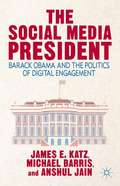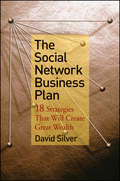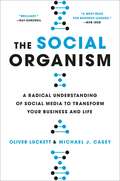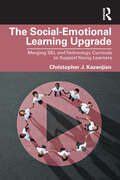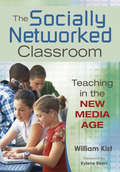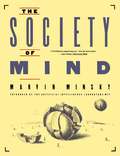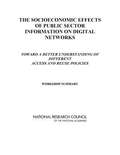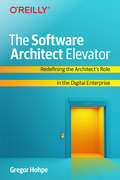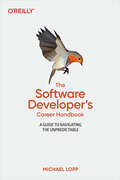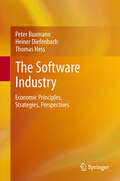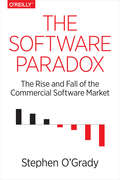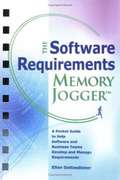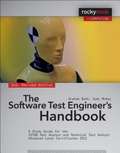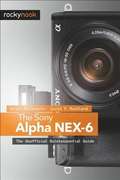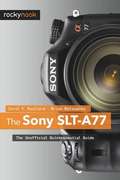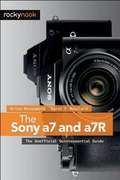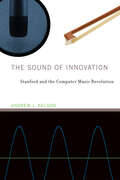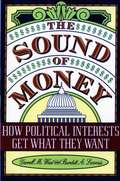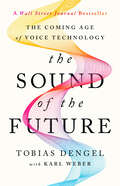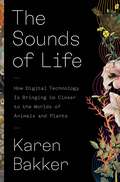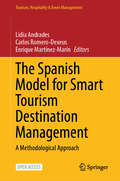- Table View
- List View
The Social Media President
by James E. Katz Michael Barris Anshul JainThe proliferation of social media has altered the way that people interact with each other - leveling the channels of communication to allow an individual to be "friends" with a sitting president. In a world where a citizen can message Barack Obama directly, this book addresses the new channels of communication in politics, and what they offer.
The Social Network Business Plan
by David SilverAll of us know that users of the Web do not read advertisements on the websites we visit, yet the online communities are emerging as the next great media rely solely on this method to produce revenue. In The Social Network Business Plan, social network expert, David Silver presents and explains 18 cutting-edge methods to create revenue for social network websites--none of which are advertising. He also predicts the demise of seemingly successful online communities such as MySpace and Facebook that rely on advertising as non-sustainable modalities. Silver describes and explains that in the future new products and services will be introduced, talked about, rated, reviewed and recommended - or killed - by online communities. One example of the 18 new revenue channels that online communities are adopting is the sale to vendors of anonymized conversations of the community members concerning those vendors' products or services. Another example is online communities who partner with the internet providers to receive payment when a particular online community's information is downloaded usinf that providers service. The other sixteen revenue channels are equally head-turning!Silver is the only angel investor, operating down where the rubber meets the road, who is investing in online communities in their infancy, and writing about which ones will win and which ones will fail.
The Social Organism: A Radical Understanding of Social Media to Transform Your Business and Life
by Michael Casey Oliver Luckett"A must-read for business leaders and anyone who wants to understand all the implications of a social world."-Bob Iger, Chairman and Chief Executive Officer of The Walt Disney CompanyFrom tech visionaries Oliver Luckett and Michael J. Casey, a groundbreaking, must-read theory of social media -- how it works, how it's changing human life, and how we can master it for good and for profit.In barely a decade, social media has positioned itself at the center of twenty-first century life. The combined power of platforms like Facebook, Twitter, Instagram, Snapchat, and Vine have helped topple dictators and turned anonymous teenagers into celebrities overnight. In the social media age, ideas spread and morph through shared hashtags, photos, and videos, and the most compelling and emotive ones can transform public opinion in mere days and weeks, even attitudes and priorities that had persisted for decades. How did this happen? The scope and pace of these changes have left traditional businesses -- and their old-guard marketing gatekeepers -- bewildered. We simply do not comprehend social media's form, function, and possibilities. It's time we did.In The Social Organism, Luckett and Casey offer a revolutionary theory: social networks -- to an astonishing degree -- mimic the rules and functions of biological life. In sharing and replicating packets of information known as memes, the world's social media users are facilitating an evolutionary process just like the transfer of genetic information in living things. Memes are the basic building blocks of our culture, our social DNA. To master social media -- and to make online content that impacts the world -- you must start with the Social Organism.With the scope and ambition of The Second Machine Age and James Gleick's The Information, The Social Organism is an indispensable guide for business leaders, marketing professionals, and anyone serious about understanding our digital world -- a guide not just to social media, but to human life today and where it is headed next.
The Social-Emotional Learning Upgrade: Merging SEL and Technology Curricula to Support Young Learners
by Christopher J. KazanjianThe Social-Emotional Learning Upgrade explores how today’s educators can connect two previously separated but important curricula in their schools: social-emotional learning (SEL) and educational technology. With schools’ SEL efforts pressed for time and resources and digital engagements often limited to skill development, K-12 students risk being unprepared to sustain their well-being and personal opportunities in a rapidly changing, technology-dependent world. Driven by a paradigm that synthesizes multicultural education and humanistic psychology, this book readies educators to implement SEL curricula that will support young learners as they navigate constant social and technological flux and that will nurture their unique perceptions of reality, their aspirations, and their mental and physical health. Each chapter’s novel insights will help to mitigate both student disengagement and teacher demoralization, enabling classroom pedagogies and the process of schooling to better align with the ways in which learners explore, express, and create meaning. Guiding pre-service teachers, leaders, and curriculum developers beyond common goals such as digital skills development, content mastery, or standardized testing, this volume focuses instead on complex digital literacies, collaborative experiences, problem- and project-based learning, culturally relevant pedagogies, and overall holistic growth.
The Socially Networked Classroom: Teaching in the New Media Age
by William R. KistIncorporate social networking into instruction, no matter your level of technological expertise or Internet access! With appropriate guidance, students’ social networking skills can be harnessed for teaching and learning in the 21st century. William Kist demonstrates how pioneering teachers have successfully integrated screen-based literacies into instruction and provides: Real-world activities and lesson examples for Grades 5–12, with assignment sheets, assessments, and rubrics Ideas on fostering collaborative learning using blogs, wikis, nings, and other interactive media. Tips on Internet safety, blogging etiquette, protected blogging sites, and more Blog entries from classroom teachers
The Society of Mind
by Marvin MinskyMarvin Minsky -- one of the fathers of computer science and co-founder of the Artificial Intelligence Laboratory at MIT -- gives a revolutionary answer to the age-old question: "How does the mind work?" Minsky brilliantly portrays the mind as a "society" of tiny components that are themselves mindless. Mirroring his theory, Minsky boldly casts The Society of Mind as an intellectual puzzle whose pieces are assembled along the way. Each chapter -- on a self-contained page -- corresponds to a piece in the puzzle. As the pages turn, a unified theory of the mind emerges, like a mosaic. Ingenious, amusing, and easy to read, The Society of Mind is an adventure in imagination.
The Socioeconomic Effects of Public Sector Information on Digital Networks: Toward a Better Understanding of Different Access and Reuse Policies - Workshop Summary
by National Research Council of the National AcademiesWhile governments throughout the world have different approaches to how they make their public sector information (PSI) available and the terms under which the information may be reused, there appears to be a broad recognition of the importance of digital networks and PSI to the economy and to society. However, despite the huge investments in PSI and the even larger estimated effects, surprisingly little is known about the costs and benefits of different information policies on the information society and the knowledge economy. By understanding the strengths and weaknesses of the current assessment methods and their underlying criteria, it should be possible to improve and apply such tools to help rationalize the policies and to clarify the role of the internet in disseminating PSI. This in turn can help promote the efficiency and effectiveness of PSI investments and management, and to improve their downstream economic and social results. The workshop that is summarized in this volume was intended to review the state of the art in assessment methods and to improve the understanding of what is known and what needs to be known about the effects of PSI activities.
The Software Architect Elevator: Redefining the Architect's Role in the Digital Enterprise
by Gregor HohpeAs the digital economy changes the rules of the game for enterprises, the role of software and IT architects is also transforming. Rather than focus on technical decisions alone, architects and senior technologists need to combine organizational and technical knowledge to effect change in their company’s structure and processes. To accomplish that, they need to connect the IT engine room to the penthouse, where the business strategy is defined.In this guide, author Gregor Hohpe shares real-world advice and hard-learned lessons from actual IT transformations. His anecdotes help architects, senior developers, and other IT professionals prepare for a more complex but rewarding role in the enterprise.This book is ideal for:Software architects and senior developers looking to shape the company’s technology direction or assist in an organizational transformationEnterprise architects and senior technologists searching for practical advice on how to navigate technical and organizational topicsCTOs and senior technical architects who are devising an IT strategy that impacts the way the organization worksIT managers who want to learn what’s worked and what hasn’t in large-scale transformation
The Software Arts (Software Studies)
by Warren SackAn alternative history of software that places the liberal arts at the very center of software's evolution.In The Software Arts, Warren Sack offers an alternative history of computing that places the arts at the very center of software's evolution. Tracing the origins of software to eighteenth-century French encyclopedists' step-by-step descriptions of how things were made in the workshops of artists and artisans, Sack shows that programming languages are the offspring of an effort to describe the mechanical arts in the language of the liberal arts. Sack offers a reading of the texts of computing—code, algorithms, and technical papers—that emphasizes continuity between prose and programs. He translates concepts and categories from the liberal and mechanical arts—including logic, rhetoric, grammar, learning, algorithm, language, and simulation—into terms of computer science and then considers their further translation into popular culture, where they circulate as forms of digital life. He considers, among other topics, the “arithmetization” of knowledge that presaged digitization; today's multitude of logics; the history of demonstration, from deduction to newer forms of persuasion; and the post-Chomsky absence of meaning in grammar. With The Software Arts, Sack invites artists and humanists to see how their ideas are at the root of software and invites computer scientists to envision themselves as artists and humanists.
The Software Developer's Career Handbook: A Guide to Navigating the Unpredictable
by Michael LoppAt some point in your career, you'll realize there's more to being a software engineer than dealing with code. Is it time to become a manager? Or join a startup? In this insightful and entertaining book, Michael Lopp recalls his own make-or-break moments with Silicon Valley giants such as Apple, Slack, Pinterest, Palantir, Netscape, and Symantec to help you make better, more mindful career decisions.With more than 40 stand-alone stories, Lopp walks through a complete job lifecycle, starting with the interview and ending with the realization that it might be time to move on. You'll learn how to handle baffling circumstances in your job, understand what you want from your career, and discover how to thrive in your workplace.Learn how to navigate areas of your job that don't involve writing codeIdentify how the aspects you enjoy will affect your next career stepsBuild and maintain key relationships and interactions within your communityMake choices that will help you have a "deliberate career"Recognize what's important to your manager and work on things that matter
The Software Developer's Guide to Linux: A practical, no-nonsense guide to using the Linux command line and utilities as a software developer
by David Cohen Christian SturmA must-read for software developers lacking command-line skills, focusing on Linux. It provides transferable command-line proficiency for use in Mac OS, Unix, and Windows with WSLKey FeaturesA practical, no-nonsense guide specifically written for developers (not sysadmins) who need to quickly learn command-line skillsExpand your practical skills and look like a wizard on the command lineBuild practical skills to work effectively with the most common CLI tools on Unix-like systemsBook DescriptionDevelopers are always looking to raise their game to the next level, yet most are completely lost when it comes to the Linux command line. This book is the bridge that will take you to the next level in your software development career. Most of the skills in the book can be immediately put to work to make you a more efficient developer. It’s written specifically for software engineers, not Linux system administrators, so each chapter will equip you with just enough theory to understand what you’re doing before diving into practical commands that you can use in your day-to-day work as a software developer. As you work through the book, you’ll quickly absorb the basics of how Linux works while you get comfortable moving around the command line. Once you’ve got the core skills, you’ll see how to apply them in different contexts that you’ll come across as a software developer: building and working with Docker images, automating boring build tasks with shell scripts, and troubleshooting issues in production environments. By the end of the book, you’ll be able to use Linux and the command line comfortably and apply your newfound skills in your day-to-day work to save time, troubleshoot issues, and be the command-line wizard that your team turns to.What you will learnLearn useful command-line tricks and tools that make software development, testing, and troubleshooting easyUnderstand how Linux and command line environments actually workCreate powerful, customized tools and save thousands of lines of code with developer-centric Linux utilitiesGain hands-on experience with Docker, SSH, and Shell scripting tasks that make you a more effective developerGet comfortable searching logs and troubleshooting problems on Linux serversHandle common command-line situations that stump other developersWho this book is forThis book is for software developers who want to build practical Command-Line (CLI) and Linux skills and who want to quickly fill the gap to advance their skills and their career. Basic knowledge of editing text, working with files and folders, having some idea of what “operating systems” are, installing software, and using a development environment is assumed.
The Software Industry: Economic Principles, Strategies, Perspectives
by Thomas Hess Peter Buxmann Heiner DiefenbachWhether ERP software, office applications, open-source products or online games: In terms of its economic characteristics, software differs fundamentally from industrial goods or services. Based on the economic principles and rules of the software industry, the book reveals strategies and business models to software vendors that comprise cooperation, distribution, pricing and production and industrialization strategies, as well as software as a service and platform concepts. Further aspects including the outsourcing behavior of software vendors and users; providing business software as open source software; selecting software; and the value chains in the software industry are also addressed. Based on a number of expert meetings, it contains numerous case studies and new empirical findings. Target audience of the book are professionals and executives from the software, consulting and IT branches as well as students and scholars of business administration, computer science, business and industrial engineering.
The Software Paradox: The Rise and Fall of the Commercial Software Market
by Stephen O'GradySoftware is more important than ever today and yet its commercial value is steadily declining. Microsoft, for instance, has seen its gross margins decrease for a decade, while startups and corporations alike are distributing free software that would have been worth millions a few years ago.Welcome to the software paradox. In this O’Reilly report, RedMonk’s Stephen O’Grady explains why the real money no longer lies in software, and what it means for companies that depend on that revenue. You’ll learn how this paradox came about and what your company can do in response.This book covers:Why it’s growing more difficult to sell software on a standalone basisHow software has come full circle, from enabler to product and back againThe roles that open source, software-as-a-service, and subscriptions playHow software developers have become the new kingmakersWhy Microsoft, Apple, and Google epitomize this transitionHow the paradox has affected other tech giants, such as Oracle and Salesforce.comStrategies your software firm can explore, including alternative revenue models
The Software Requirements Memory Jogger: A Pocket Guide to Help Software and Business Teams Develop and Manage Requirements
by Ellen GottesdienerThe Software Requirements Memory Jogger is an easy-to-use guide for developing and managing precise software requirements. The Software Requirements Memory Jogger provides every member of your project team with the tools and techniques to foster communication between business and technical teams on the necessary requirements for producing successful software. The Software Requirements Memory Jogger will benefit all stakeholders at any organizational level involved in software development projects management team, practitioners, QA/QC personnel. - Explore practical steps, tips, and examples to help you develop and manage requirements - Follow the User Requirements Roadmap a toolkit of techniques for discovering and analyzing user requirements - Streamline communications between all requirements stakeholders - Learn how to write clear, concise requirements documents
The Software Test Engineer's Handbook
by Judy Mckay Graham BathRevised and updated 1st Edition, 2011 There are a lot of books around covering functional testing techniques, but relatively few cover both functional and technical testing. This book will fill that gap. Authors Graham Bath and Judy McKay are core members of the ISTQB Working Party that created the new advanced level syllabus, which will be rolled out worldwide this year. This book brings both functional and technical aspects of testing into a coherent whole, which will benefit not only test analyst/engineers but also test managers. Based on the "Certified Tester" Advanced-Level syllabus issued by the ISTQB in 2007, the book covers everything you will need to know to successfully sit the examinations for Test Analyst and Technical Test Analyst. For those planning to take one or both of these exams, the book provides a solid base for preparation and clearly indicates which sections apply to which specific examination.
The Sony Alpha NEX-7
by Brian Matsumoto Carol F. RoullardThe Sony Alpha NEX-7: The Unofficial Quintessential Guide provides a wealth of experience-based information and insights for owners of this exciting new camera. Authors Carol F. Roullard and Brian Matsumoto team up to help the new user navigate past the confusion factor that often comes with complex and powerful camera equipment. This book explores the features and capabilities of the camera in a way that far surpasses the user's manual. It guides you through the camera features with step-by-step setting adjustments and detailed how, when, and why explanations for each option. Every button, dial, switch, and menu configuration setting is explored in a friendly manner, with suggestions and tips for setup according to various shooting styles. The informative text is illustrated with screenshots and example images throughout, making it easy to follow along. The authors cover everything from the basic features of the camera to numerous advanced photographic applications. The first section of the book teaches the new user to start taking pictures immediately by using the camera's Intelligent Automatic mode. The second section covers how to begin taking more control by switching to the semi-automatic modes. Finally, you'll learn to take full manual control of the camera, allowing you to break some "rules" and capture images that are a unique reflection of your creative personality. Carol and Brian go beyond just the camera itself and share how third-party software and optional accessories can improve on the camera's standard commands. You'll even learn how the electronic viewfinder, the fixed mirror, and Sony's novel shutter design improve the camera's utility for critical scientific photography (i.e., photomicrography and photography through the telescope).The Sony Alpha NEX-7: The Unofficial Quintessential Guide will allow you to really take control of your camera, to push the envelope, and to have fun.
The Sony SLT-A77
by Brian Matsumoto Carol F. RoullardThis book provides enthusiastic photographers with a wealth of information about the unique features of the Sony SLT-A77, an interchangeable-lens camera with an electronic viewfinder and a fixed, translucent mirror. The A77 differs from the current crop of DSLRs in its ability to use a phase detection focusing system throughout the entire picture-taking process, for both still photographs and videos. This provides an immediacy and responsiveness when using burst shots and creating HD videos that is unavailable in any other camera. In this guide, authors Carol Roullard and Brian Matsumoto teach you how to obtain exceptional photographs and videos as they cover everything from the basics of using the camera's automatic modes, to the more advanced aperture-priority, shutter-priority, program, and manual exposure modes. You'll also learn how best to take advantage of features such as the built-in dynamic range adjustment, sweep panoramic, GPS, colorization modes, facial detection and recognition, multiple shot exposures, and HD video. The authors provide you with an opportunity to improve your skills even further by discussing how third-party software and accessories can improve Sony's standard commands. You'll also learn about how the electronic viewfinder, fixed mirror, and Sony's novel shutter design improve the camera's utility for scientific photography through the microscope and telescope. Additional topics include:Advantages of the electronic viewfinder for previewing your photographs Using the accessory Sony shoe-mount flash Advantages of using the JPEG file format Advantage of having a fixed mirror and electronic first curtain shutter Settings for using the camera on a microscope and telescope Using the older Minolta Maxxum lenses
The Sony a7 and a7R
by Brian Matsumoto Carol F. RoullardThis book is a guide to using the Sony a7 and a7R, the first full frame, autofocus system cameras. At half the weight of a full frame DSLR, they are easy to carry for photographers on the go. The less-expensive a7 has a 24-megapixel sensor for shooting rapidly changing scenes; the a7R has a 36-megapixel sensor designed for ultimate image sharpness. Both use advanced image-processing algorithms and can use any manufacturer's lens when matched with the appropriate adapter. The electronic viewfinder gives the photographer an accurate preview of the image, ensuring the capture of technically excellent photographs by preventing mistakes in color temperature, depth of field, and exposure. All features of the a7 and a7R are covered, including automatic stitching to create panoramas, and multi-shot noise reduction that allows the use of extremely high ISOs. This book guides the photographer in using both the camera's automated features and manual controls to take photographs that are a unique reflection of his or her creative personality.
The Sound of Innovation: Stanford and the Computer Music Revolution (Inside Technology)
by Andrew J. NelsonHow a team of musicians, engineers, computer scientists, and psychologists developed computer music as an academic field and ushered in the era of digital music.In the 1960s, a team of Stanford musicians, engineers, computer scientists, and psychologists used computing in an entirely novel way: to produce and manipulate sound and create the sonic basis of new musical compositions. This group of interdisciplinary researchers at the nascent Center for Computer Research in Music and Acoustics (CCRMA, pronounced “karma”) helped to develop computer music as an academic field, invent the technologies that underlie it, and usher in the age of digital music. In The Sound of Innovation, Andrew Nelson chronicles the history of CCRMA, tracing its origins in Stanford's Artificial Intelligence Laboratory through its present-day influence on Silicon Valley and digital music groups worldwide. Nelson emphasizes CCRMA's interdisciplinarity, which stimulates creativity at the intersections of fields; its commitment to open sharing and users; and its pioneering commercial engagement. He shows that Stanford's outsized influence on the emergence of digital music came from the intertwining of these three modes, which brought together diverse supporters with different aims around a field of shared interest. Nelson thus challenges long-standing assumptions about the divisions between art and science, between the humanities and technology, and between academic research and commercial applications, showing how the story of a small group of musicians reveals substantial insights about innovation. Nelson draws on extensive archival research and dozens of interviews with digital music pioneers; the book's website provides access to original historic documents and other material.
The Sound of Money: How Political Interests Get What They Want
by Darrell M. West Burdett A. LoomisIn their compelling new book, The Sound of Money: How Political Interests Get What They Want, West and Loomis probe the connection between interest-group spending and congressional policy making. In recent years, important battles have been fought over health care reform, telecommunications deregulation, and Medicare, to name just a few. The interest groups most successful at influencing policy are those with the most money to spend on advertising and lobbying. West and Loomis caution that as the "sound" of money in American politics grows louder, this new group activism will increasingly affect-and maybe even threaten-the viability of representative government.
The Sound of the Future: The Coming Age of Voice Technology
by Tobias DengelA Wall Street Journal Bestseller A USA Today Bestseller Why voice technology is the next big thing in technology, as big as mobile a decade ago and the internet in the late 90s, fundamentally altering the way companies do business. Voice is the next technology – remarkably similar in potential impact to the internet and mobile computing - poised to change the way the world works. Tobias Dengel is in the vanguard of this breakthrough, understanding the deep, wide-ranging implications voice will have for every industry. In The Sound of the Future, he connects the dots about this emerging paradigm to vividly illustrate how business leaders can stay ahead of the game, rather than scrambling to catch up, as voice technology gradually reveals its power, creating a host of new winners and losers. Using fascinating, colorful stories, Dengel explains how the &“voice-first&” experience is becoming part of the global technology mainstream, exploring the ways voice will do a better job of serving basic human needs such as safety, speed, accuracy, convenience, and fun, as well as making it possible for hundreds of millions of people around the planet to participate more fully and productively in today&’s high-tech world by making interactions with technology virtually effortless. A pervasive technology like the internet and mobile, voice, with applications in marketing, sales, service, manufacturing, and logistics, will change the way we work at every level and every function, driving down costs, boosting productivity, and enabling the creation of entirely new business models. This is not simply about Siri and Alexa. They are the tantalizing but incomplete precursors of the ultimate interface that will make technology easier, faster, more accurate, and more human.
The Sounds of Life: How Digital Technology Is Bringing Us Closer to the Worlds of Animals and Plants
by Karen BakkerAn amazing journey into the hidden realm of nature&’s soundsThe natural world teems with remarkable conversations, many beyond human hearing range. Scientists are using groundbreaking digital technologies to uncover these astonishing sounds, revealing vibrant communication among our fellow creatures across the Tree of Life.At once meditative and scientific, The Sounds of Life shares fascinating and surprising stories of nonhuman sound, interweaving insights from technological innovation and traditional knowledge. We meet scientists using sound to protect and regenerate endangered species from the Great Barrier Reef to the Arctic and the Amazon. We discover the shocking impacts of noise pollution on both animals and plants. We learn how artificial intelligence can decode nonhuman sounds, and meet the researchers building dictionaries in East African Elephant and Sperm Whalish. At the frontiers of innovation, we explore digitally mediated dialogues with bats and honeybees. Technology often distracts us from nature, but what if it could reconnect us instead?The Sounds of Life offers hope for environmental conservation and affirms humanity&’s relationship with nature in the digital age. After learning about the unsuspected wonders of nature&’s sounds, we will never see walks outdoors in the same way again.
The Soundtrack Composer's Ultimate Guide to FL Studio: Learn to score films and games, compose orchestral music, and launch your music career
by Joshua Au-YeungCreate and compose production-quality music with the power of FL Studio 20 along with MuseScore and WwiseKey FeaturesDevelop widely applicable music composition techniques and create full orchestral scoresLeverage the power of FL Studio to create your own production-level soundtracksUse cutting-edge tools to fuel your creative ideas and launch your composer careerBook DescriptionFL Studio is a cutting-edge software music production environment and a powerful and easy-to-use tool for composing music. In this comprehensive guide, you'll discover how to use FL Studio's tools and techniques to design exciting soundtracks for your films, TV shows, video games, and much more. You'll start by understanding the business of composing, learning how to communicate, score, market your services, land gigs, and deliver music projects for clients like a professional. Next, you'll set up your studio environment, navigate key tools, such as the channel rack, piano roll, playlist, mixer, and browser, and export songs. The book then advances to show you how to compose orchestral music using MIDI (musical instrument digital interface) programming, with a dedicated section to string instruments. You'll create sheet music using MuseScore for live musicians to play your compositions. Later, you'll learn about the art of Foley for recording realistic sound effects, create adaptive music that changes throughout video games, and design music to trigger specific emotions, for example, eerie music to terrify your listener. Finally, you'll work on a sample project that will help you prepare for your composing career. By the end of this book, you'll be able to create professional soundtrack scores for your films and video games.What you will learnCompose production-ready music for films and video gamesPlan and deliver a soundtrack music score for clients like a professionalApply practical music theory using themes, leitmotifs, scales, and modesCompose orchestral music with MIDI programmingDesign music for specific emotionsCreate sheet music with MuseScore, score music for films with Fruity Video Player, and make diegetic musicDesign interactive music by leveraging horizontal resequencing and vertical remixingWho this book is forThis book is for musicians and programmers who want to take their music composing skills to a professional level. Film directors and game designers who want to get involved in scoring music for their own productions will also find this book useful. All you need is a computer and FL Studio to get started.
The Spanish Armada: A Ladybird Expert Book (The Ladybird Expert Series #30)
by Sam WillisPart of the ALL-NEW LADYBIRD EXPERT SERIES.____________Why did the Spanish launch their Armada on England?How did Francis Drake counter the Spanish threat?And why were so many ships lost at sea?In 1585 Spain was the most POWERFUL Empire in the known world.As tensions between PROTESTANT England and CATHOLIC Spain rose . . . SPAIN decided to INVADE ENGLAND. And launched the SPANISH ARMADA This raises the question: how did England manage to overthrow the Spanish invasion? Was it luck or judgement? Discover the answers and more inside Sam Willis's Ladybird Expert - The Spanish Armada, the thrilling and accessible account that explains what happened, who the key figures were and the tactics, triumphs and failures on both sides . . .
The Spanish Model for Smart Tourism Destination Management: A Methodological Approach (Tourism, Hospitality & Event Management)
by Lidia Andrades Carlos Romero-Dexeus Enrique Martínez-MarínThis is an open access handbook that guides destinations on their journey to becoming Smart Tourism Destinations (STDs). Developed by SEGITTUR, a distinguished Spanish State company, and aligned with academia represented by Professor Lidia Andrades, who has brought together recognized international academics with SEGITTUR experts in the field of tourism management to write this groundbreaking book, it offers practical insights and strategies for success. Explore the characteristics and implications of smart destinations, across the five dimensions which structure them: destination governance, accessibility, technology, innovation and sustainability, navigate the transition from traditional tourism management to the innovative smart managerial paradigm, and overcome challenges encountered during the transformative process. Equipping destination managers with essential tools and strategies, this handbook showcases real-life examples of Spanish destinations embracing the smart tourism paradigm. Drawing on SEGITTUR's proven methodology, it provides precise guidance, checklists, and expert recommendations for effective implementation. An invaluable resource for destination managers, tourism professionals, and researchers, it unlocks the full potential of smart tourism destinations.
